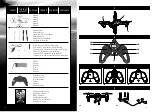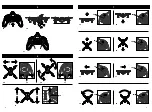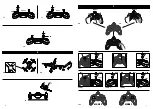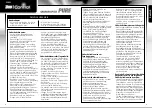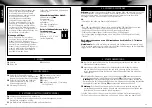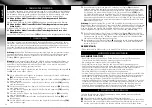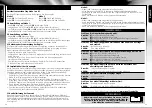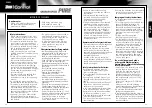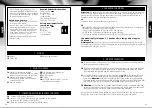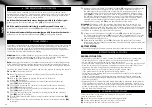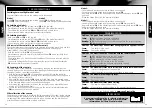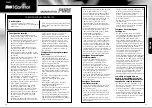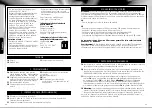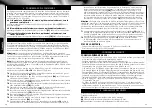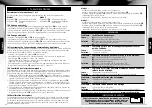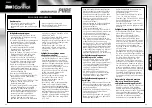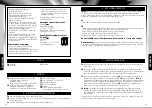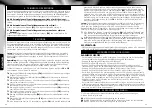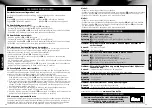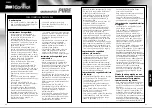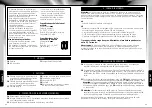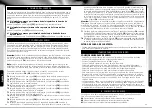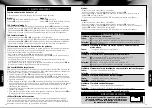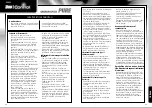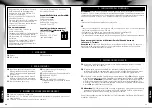
English
7 FLIGHT CONTROL
The model is equipped with an automatic altitude control assistant that makes it possible
to learn how to control the model quickly and easily. The assistant is a sensor that can
measure the air pressure to within 10 centimetres of the exact altitude and thereby
automatically keep the quadrocopter at the specified altitude. Therefore, beginners can
concentrate on forward/backwards and banking.
Attention:
Due to outside influences, the pressure inside the model may change,
causing the model to automatically rise or lower. This is not a defect. Briefly actuating
the control for thrust and rotation
2A
is sufficient to counteract this.
Note:
Only minimal corrections of the controls are necessary for a smooth flying behavior
of the model! The direction indication applies when the model is viewed from behind. If
the model is flying forwards towards the pilot, it must be moved in the opposite direction.
Switch on the model as shown in point 5 and start the rotators by moving the controls
2A
and
2B
to the bottom outside.
7A
Take off or increase altitude by carefully moving the control for thrust and
rotation
(2A)
forward.
7B
Land or decrease altitude by moving the control for thrust and
rotation
(2A)
backward.
7C
Fly forward by moving the controller for forward/backward and sideways
flight
(2B)
carefully forward.
7D
Fly backward by moving the controller for forward/backward and sideways
flight
(2B)
carefully backward.
7E
Fly to the left by moving the controller for forward/backward and sideways
flight
(2B)
carefully to the left.
7F
Fly to the right by moving the controller for forward/backward and sideways
flight
(2B)
carefully to the right.
7G
Turn the model around to the left by moving the control for thrust and rotation
(2A)
to the left.
7H
Turn model around to the right by moving the control for thrust and rotation
(2A)
to the right.
The model must be switched on first in order to connect it to the remote control.
Its adjustment is simple, but it requires some patience and a feel for it. Please observe
the following instructions precisely: Carefully move the thrust control up and raise the
helicopter approximately 0.5 to 1 metre in altitude.
6 TRIM ADJUSTMENT OF THE CONTROL
6B If the model moves by itself slowly or quickly around its own axis …
press the trim adjustment for rotation
(2C)
incrementally in the opposite direction.
6C If the model automatically moves slowly or quickly forwards or backwards ...
gradually press the forwards/backwards trim
(2D)
in the opposite direction.
6A If the model automatically moves slowly or quickly to the left or right ...
gradually press the trim for sideways flight
(2E)
in the opposite direction.
English
7I
A vertical, short press (about 0,3 seconds) of control
2A
activates the headless mode.
Headless mode supports beginners in the initial stages. Regardless of where
the quadrocopter turns, the direction of flight always corresponds exactly to the
direction specified with the control for forwards/backwards and sideways move-
ment
(2B)
. An example: If the model were to be turned 180° and flown towards
the operator, the operator would have to „convert“ the forwards/backwards and
sideways movement accordingly. This is no longer necessary if headless mode is
activated, as the internal processor always converts the control directions
automatically. Pressing the
2A
button again deactivates the mode.
Attention:
The model „notes“ the forwards direction during each switch-on. This
means that the operator must not turn when controlling the model, as this would
change the concept of „forwards“ and „right/left“ in relation to the model. If the operator
changes position and wants to use headless mode - or if the control direction is no longer
correct due to a collision, the model must be restarted.
BATTERY STATUS:
• The battery is empty if the model begins to lose thrust. Land in order to avoid crashing.
INSTRUCTIONS FOR SAFE FLYING
GENERAL FLYING TIPS:
• Always place the model on a level surface. An inclined surface can, under certain
circumstances, have a negative impact on the starting behavior of the model.
• Always operate the controls slowly and with a gentle touch.
• Always maintain visual contact with the model and do not look at the remote control!
• Move the thrust control down again somewhat as soon as the model lifts off from
the ground. Maintain flying altitude by adjusting the thrust controller.
• If the model lowers, move the thrust control slightly upward again.
• If the model climbs, move the thrust control down slightly.
• To fly along a curve, tapping the directional controller very slightly in the respective
direction often suffices.
There is a general tendency during preliminary attempts at flight to operate the
model‘s controls too aggressively.Always operate the controls slowly and carefully.
Never fast and fitfully.
• Beginners should first master trimming before attempting to master the thrust controller.
The model does not necessarily have to fly straight at the beginning - initially, it is
more important to maintain a constant height of approximately one meter above the
ground by repeatedly tapping the thrust control. Only then should the pilot practice
steering the model left and right.
8 CHANGING THE PROPELLERS
If the rotor blades on the model are damaged, they must be replaced.
To do so, proceed as follows:
8A
Ensure the correct arrangement of the rotors during installation.
8B
Use the accompanying removal tool to pull off the rotors.
8C
Carefully press the new rotor on the motor shaft.
7J
A longer vertical press (about 2 seconds) of control
2A
activates the flip function.
The next movement with control
2B
allows the model to complete a 360° flip in the
corresponding direction. In the process, ensure a safety altitude of about 2 metres
and a sufficiently charged battery.
7K
Briefly pressing vertically on control
2B
activates the 2nd speed level. The remote
control issues two short beeps as confirmation. Pressing the button again switches back
to the first speed level.
20
21


